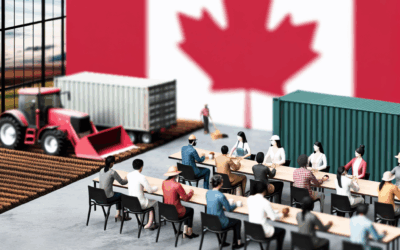Canada’s Economic Crossroads: Growth Meets Global Headwinds in April 2025
As of April 7, 2025, the Canadian economy is navigating a complex landscape marked by early-year growth tempered by emerging challenges, particularly from international trade tensions and sector-specific disruptions.
In January, Canada’s real GDP expanded by 0.4% month-over-month, surpassing expectations. This growth was broad-based, with 13 out of 20 industries reporting gains, notably in the goods-producing sectors, which saw a 1.1% increase. The services sector also experienced modest growth of 0.1%. However, preliminary estimates for February suggest the economy remained flat, raising concerns about a slowdown in momentum.
One of the most significant factors shaping the economic outlook is the wave of new U.S. trade policies. The Trump administration’s imposition of sweeping tariffs on Canadian goods—including a 25% levy on many products and a 10% duty on energy exports—has triggered widespread concern. Dubbed the “Liberation Day” tariffs, the measures could jeopardize up to one million Canadian jobs, with Ontario and Quebec expected to be hardest hit.
The automotive sector, in particular, is under intense pressure. A Detroit-based automotive advisory firm, Telemetry, forecasts a drop in auto sales by 1.8 million units across Canada and the U.S. in 2025 due to escalating global trade tensions. If the tariffs persist through 2035, cumulative light-duty vehicle sales could be short by 7 million units compared to a scenario with stable trade. In response, major automakers such as General Motors and Stellantis are adjusting production plans and offering higher consumer incentives to offset potential price increases. The effects are rippling across the manufacturing ecosystem, impacting employment, investment, and supply chains.
The mood among Canadian businesses and consumers reflects these mounting pressures. The Bank of Canada’s first-quarter Business Outlook Survey showed that 32% of companies now expect a recession within the next year—double the number from late 2024. Two-thirds of consumers also report concerns about the country’s economic direction, attributing much of their anxiety to inflation and the volatility of international trade.
Inflation is another growing concern. About 65% of businesses anticipate rising costs, and 40% plan to raise their prices. Canada’s annual inflation rate hit 2.6% in February, prompting the Bank of Canada to consider further interest rate cuts. Markets are now anticipating an eighth consecutive cut, which could lower the policy rate to 2.5% in an effort to stimulate spending and ease financial strain.
Financial markets are mirroring this unease. On April 7, the S&P/TSX futures fell by 2.1%, hitting their lowest level since August 2024. The Canadian dollar has also weakened against the U.S. dollar and other major currencies, reflecting investor caution.
Beyond the trade and inflation story, Canada’s housing market is once again heating up. With interest rates trending downward and new federal policies allowing extended mortgage amortization, home prices are expected to rise above $700,000 by year-end. While this is good news for homeowners and developers, it poses a growing challenge for first-time buyers and exacerbates the country’s housing affordability crisis.
Labor market dynamics are also shifting. Work stoppages and strike activity are on the rise, driven by higher unit labor costs, affordability concerns, and demands for better working conditions in the face of automation. At the same time, productivity has declined for the third consecutive quarter, raising red flags about Canada’s ability to sustain long-term growth without significant innovation or investment in workforce efficiency.
Adding to the uncertainty, Canada’s immigration policy is undergoing a reset. The federal government has announced plans to reduce the share of non-permanent residents, aiming to ease pressure on housing and public services. While this may help stabilize infrastructure demand, it could also dampen labor supply and consumer spending, particularly in urban centers that rely on population growth to drive economic momentum.
In response to these pressures, provinces are stepping up. Ontario, for example, has introduced an $11 billion relief package that includes tax deferrals and job protection incentives, especially targeted at manufacturers and energy-intensive industries. These initiatives complement earlier federal programs announced in March, which aim to support trade diversification, provide emergency business financing, and mitigate layoffs in hard-hit sectors.
Internationally, Canada has escalated its trade dispute with the U.S. to the World Trade Organization, challenging the legality of the auto tariffs under the General Agreement on Tariffs and Trade. While the case is expected to take months, if not years, to resolve, it marks a turning point in Canada’s approach to defending its economic interests on the global stage.
In summary, while Canada entered 2025 with a degree of economic momentum, that energy is now being tested. Trade tensions, inflation, labor friction, and structural vulnerabilities—particularly in housing and productivity—are converging. Whether the economy stabilizes or slides further into uncertainty will depend heavily on coordinated policy responses, international diplomacy, and the resilience of Canadian businesses and households in the face of mounting headwinds.



